November 20, 2014
TEZPUR to ZIRO - 290 km
Abasa Guesthouse 1000Rs ($16.10) per person, half board
4:45 am bus-->10am Lakhimpur 170 Rs pp-->
Sumo to Ziro 300Rs pp (noon -->4:30)
Rice wine "o" w black salt
Tapyo salt substitute
Festival egg
Organic homegrown veggies
Chicken cooked in bamboo
Apatani people
Another Long Travel Day
The KF Boutique Hotel had fixed us up with a nice sack breakfast package. And at 4:45 am, in the pitch dark, we waited on the corner for the bus. This road will be closed-off later today because of the official Presidential visit. We were 'lucky' to be leaving this early.
Curious guys showed up out of the woodwork. They asked us where we are going and where we're from. "Ohh America..... California," we heard echoed as the information is passed along. Our experience has been that there are always one or two good Samaritans that look out for us. They spot the bus or sumo before we do, they help us with the luggage and make sure we get on.
A bus came by and I was spirited on by the helpers. It was packed. Dave hesitated because the bus did not come from the Tezpur road. 'Yes. Lakhimpur," we were assured. Dave still hesitated and finally they admitted that this bus was going to Itanagar and we could easily get another bus from there to Lakhimpur. "Let's wait" Dave insisted and we took my bag off the bus.
At 5:15 am, our bus arrived coming from the Tezpur entry road. Our packs got loaded on top. This bus was 3/4 full and two seats next to each other were freed up for us and off we went. It was definitively not a deluxe bus. The windows were dirty and the curtains grimy.
Through the front window, we watched the red ball of the sun rise and a gorgeous glow fall over the tea plantations and rice fields we passed. We saw more tea estates today than we did in Darjeeling - miles and miles of neatly trimmed rows of tea.
The Next Sumo
The bus conductor / ticket guy told us NOT to get off at the Pahumara crossroad. "All the Sumos to Ziro will be full by the time they get there". So we stayed on till the Sumo stand in Lakhimpur (10:00 am) There, we bought reserved seats for the 'next' Sumo and ended up waiting for two hours for that next Sumo to leave.
Back Up to Arunachal Pradesh
It's a Jungle Up There
We headed back up and into the gorgeous lush jungle covered mountains with banana palms and prolific bamboo everywhere. Poinsettias added color to the wood and bamboo houses in the small villages.
We stopped half way and bought some tasty mandarin oranges. The sky stayed overcast most of the late afternoon.
At last, at 4:00 pm, we pulled into the Sumo stand in Old Ziro also called Hapoli. Several guys huddled around a trash fire on the side of the street.
Dave had been able to contact the owners of the Abasa Home Stay we had booked and they said they would pick us up. The lovely wife Kampu came in a Mahindra Scorpio, a sturdy 4x4. She still had to pick up her 13 year old son from math tutoring. It was dark by the time we pulled up to the lovely Home Stay about 4 kilometers out of town. There we met the husband Kago Habung, a mild mannered guy. We were shown to our room, and after we cleaned up, we went down to a cozy sitting room heated by a wood stove.
We were introduced four of their five kids who sat and watched cartoons on a small TV.
The Family
Shri Kago Habung
Smti Kago Kampu
Miss Kago Ampi
Miss Kago Reela
Miss Kago Mimung
Mister Kago Sangkang
Mister Kago Saro
Habung showed us a nicely illustrated book about the traditions of the Apatani tribal people around here and who we will be visiting in a few days. He offered us some rice wine. It reminded me of the Tongba. His wife came out with festival eggs as an appetizer for us. The egg whites are mixed with vegetables then put back in the shell and cooked, pretty tasty.
Dinner was a generous spread of the most flavorful organic vegetables out of their own garden. A salad of sweet carrots, cukes and tomatoes. And a scrumptious fruit cocktail for desert in cream. Kampu showed us the indigenous 'salt' called 'tapyo.' It had a brownish hue which makes it look like it is made from ash. It tastes like salt but is not. Apatani used tapyo long before they were introduced to sea salt. Talking about wholesome food.
We turned in early.
November 21, 2014 AROUND ZIRO
Abasa Guesthouse (half board 1000Rs pp (a steal)
Apatani Farming & Wild Mithun
The clouds hung low around in the valleys around us when we awoke. Breakfast was served downstairs at 8 am; fried eggs, toast and homemade kiwi jam.
After breakfast, Habung showed us his extensive vegetable garden and a model of an Apatani bamboo house he built behind his house. Newer Apatani houses incorporate tin roofs and concrete or bricks. Habung wanted one made the traditional way with traditional materials. They usually are built on a raised platform.
We opted to enjoy the surroundings of the Abasa Home Stay on foot in the afternoon. The undulating valley is dotted with wooden and bamboo houses, nicely sculpted rice fields and surrounded by pine and bamboo clad mountains. It was pretty nippy out but the walk warmed us up.
Habung told us to be on the lookout near the bridge for the wild Mithun, a gentle giant related to the cow.
We watched neighbors pitch in to fix roofs and general maintainable on each others homes. Women appear to be doing most work in the fields. We spotted a woman picking my favorite sweet peas. She was joined by an older Apatani lady with facial tattoos and nose plugs, the first we had seen. They motioned for us to come through the gate to them. I tasted the sweet peas and bought a kilo. They make great travel snacks. We were able to take some pictures and they motioned that they wanted to be paid. They were happy with our transaction and waved us goodbye.
After we crossed a pedestrian suspension bridge, we finally spotted the crazy looking Mithun. They are so tame and later we heard that they are fed salt by the person who becomes their owner. And are used in animal sacrifices. Traditionally, the mithun is allowed to move freely in jungle till it is either used for food on special occasions, marriage feasts, or barter.
November 22, 2014
Ziro Valley Villages
Hired Car & Guide
Per our LP Guide: Scenery and village architecture apart, the main attraction here is meeting the friendly older Apatani folk who sport facial tattoos and nose plugs. The most authentic Apatani villages are Hong (the biggest and best known), Hija, Hari, Bamin and Dutta.
Abasa Home Stay Arranged a Car and Driver for Us
It was a gloomy gray morning. Not the best weather for a tour of the valley.
Ailya came in and was introduced to us as both our driver and guide. We asked what he had in mind to show us. He responded by asking us what we wanted. We told him since he was the guide and we'd like some suggestions. He hesitantly explained that we would go to a traditional village and walk around. He did not have a typical program. He said we could meet some tattooed women. And if we wanted to take pictures, we should pay them. How much? Ailya suggested 100Rs per picture. We were flabbergasted by his suggestion. We said maybe we could pay a fixed amount to a village elder but we were not going to be paying each person 100Rs each time we clicked a photo. Ailya shrugged and said we'd have to work it out with the villagers.
We had to reset our expectations in a guide. Should we try to find somebody else? Alaya was a nice kid but clearly just a driver who could translate for us. That's all. We decided to stick with plan A and Alaya...
Bapo Poles and Bulyang Council
We drove in a little gray Suzuki through a nearby village with ramshackle wooden buildings. It seemed more Indian than Apatani. But Alaya pointed out a concrete platform and explained about a La Pong platform located in each village where the village elders make decisions for the village. The Bulyang council process is a characteristic of Apatani culture.
He also explained that the tall poles in front of homes signify that an boy lives in the house. But the giant bapo poles seemed to be randomly placed on the village lanes. We could not tell to which house they belonged and did not quite grasp the significance. These are a tall bamboo pole with a cross member on top like a "T". At the ends of the "T" hung a pom pom of rice stalks. In another village, the bapo had a flat rectangle weave of salks hanging like flags at the ends. We understood that they are erected during myoko (or festival) and they have special meaning. Later we looked up details on the Babo. There are two category of "BABO" called AKHA BABO and HIMEY BABO. The Akha Babo identifies the clan to which the house belongs and the Mimey Babo identifies the number of male children.
2nd Wedding and Mida (Bonding Gift Exchange)
Hija village was next and its architecture seemed more traditional Apatani with houses on raised platforms. We asked Alaya to pull over. This village seemed like a good one to walk around in.
Women came from the fields through the streets of Hija with baskets on their backs. One house had a young women walking on rice to remove the chaff . Women with nose plugs and facial tattoos peered from homes. A group was gathered down the road in front of one of the finer homes. We asked Alaya, Why are they gathered?. He said he didn't know but would ask!
The gathering was a wedding and the group was waiting for the bride and groom to arrive on foot from the bride's village several kilometers away. A dapper 40 something man, wearing an English driving cap, came over to greet us. He was a professor at a university in Itanagar and his wife the museum director there. He was also the owner of this fine house and he had come into town to host a second wedding ceremony. The groom was his younger 'brother' (a closely related male clan member). He invited us in the house and up to the roof top to have some tea. Dozens of people were chatting and waiting for the bride and groom to arrive. We were introduced to the village shaman priest who would be orating at the ceremony. Slabs of mithun meat were labeled and stacked. These wedding 'gifts' are very traditional and each has a special meaning in Apatani tradition. We let our host go to attend to other guest and eventually made our way out front to wait with the others. Different men would come and chat with us. Several of the men had their hair tied in a knot just above the forehead (locally called Piiding) One old 'professor' obliquely explained what his specialty was before wondering how many atoms were in the world....
At last, a line of women dressed in traditional Apatani costumes could be seen arriving on foot from down the road. The groom, bride and their three children were in tow. We were asked into the reception room with them. We sat and watched and were served food. Baskets with gifts of rice or wine were collected. Everything the couple touched was collected. We were told that everything they touch, plates, food, chairs, etc, will be gathered and brought back to their home.
This 'Mida' was a second wedding ceremony held seven years after the original marriage. It is held to reconfirm the commitments and obligations the bride's clan and the groom's clan have to each other.
We felt we had imposed upon there hospitality long enough and politely excused ourselves before the speeches were to begin. This visit was the highlight of our time in Ziro valley.
A Funeral
We drove though another village and passed what looked like somber gathering where they were cooking up Mithun. "Somebody died," Ailya said. We asked Ailya to stop for a closer look. He said okay but continued on to look for a good parking spot. After we were a few hundred meters down the road, and still not having found a good place to park, we told Ailya that he was right not to stop. We didn't belong there.
Ailya explained that most Apitani have converted to Christianity with Christian burials and ceremonies. But they believe in the old Donyi-Polo animistic religion too and combine the two. He said he would show us a Donyi-Polo graveyad which is much different that a Christian graveyard.
He brought us to a small field where a bamboo biyu (grave marker) was erected. It was made of bamboo poles in a standing triangle shape. One had the head of sacrificed animal on top. (Sacrifice of the animals and special rites are performed for the dead). At another spot, there was a fresh biyu. Ailya explained that he could tell that one was for a woman by the way it was made. This one was bamboo poles in a rectangle shape. Then he explained that usually these graves are placed on the property of the family farm.
Yellow Stalks and Red Algae
We arrived at a viewpoint with a broad rolling field of dry yellow rice stalks under gray clouds. We could imagine that in the growing season, this wide expanse would be emerald green waves.
We stopped at farm plots on the outskirts of another village. Red algae blanketed the surfaces of several ponds. Women stopped on the trails and chatted with each other. This area is said to be one of the most prolific rice production areas in the world. It appears the women do all the work.
We stopped by several other large villages with giant bapo poles, bamboo and wood houses on raised platforms and Bulyang stages. But by now, the scenes were redundant. we had seen enough. Then Ailya took us in to see the home of another family. Family member and a woman with a young baby circled around the central fire. It was an uncomfortable visit and after a few one sided inquires about the age of the baby and how old the ladies were when they got their facial tattoos, we thanked them and left.
Forest Rats in the Market
We still had a bit of the afternoon left and we asked Ailya to take us through the market. A light rain began but the market is covered. Several of the vegetable sellers were tattooed. On one table, there were odd looking brown things on bamboo skewers. Ailya said they were dried fish. It was dark in the market but those fish had legs. We picked up a stick and gave Ailya a closer look. "Oh, yeah." "People catch those rodents in the forest." "We eat them." We will save tasting that delicacy for another life.
Back at Abasa, Kampu had prepared another healthy and fresh meal for us. We had not asked for anything specific because by now we knew Kampu would take care of us.

 Ziro, Assam, India
Ziro, Assam, India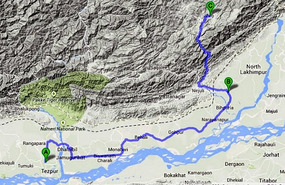
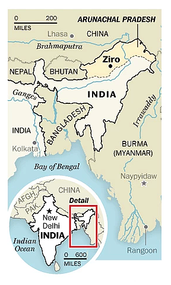
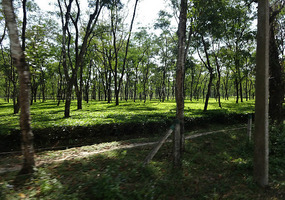
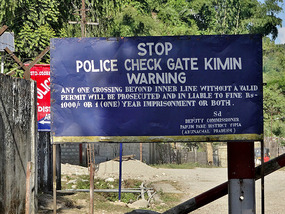
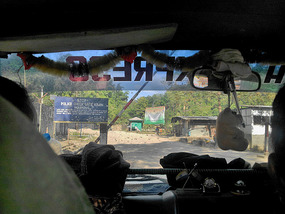
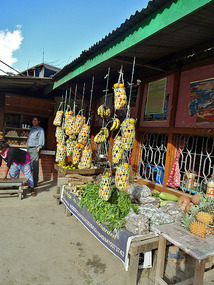
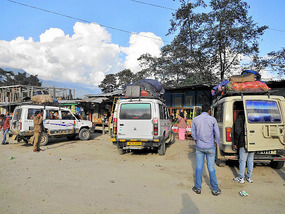
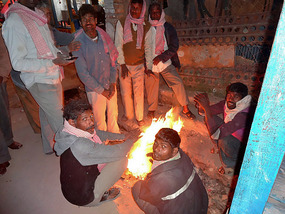
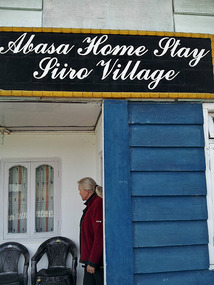

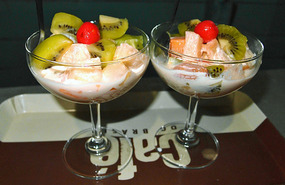
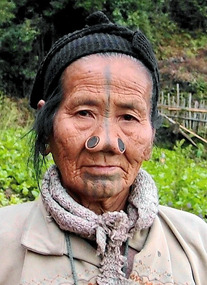
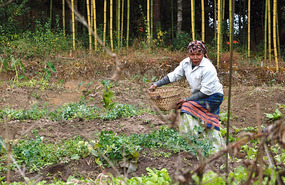
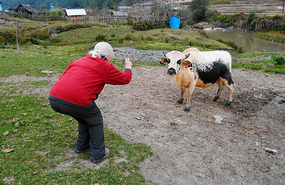
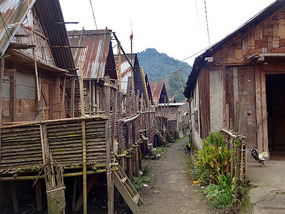
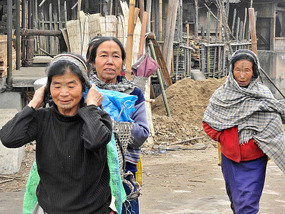
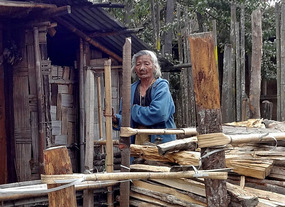
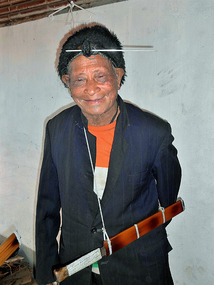
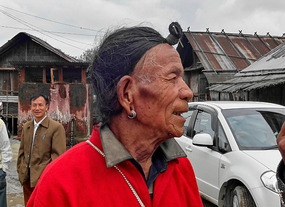
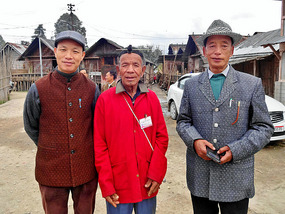
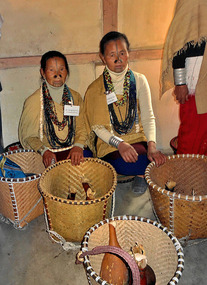
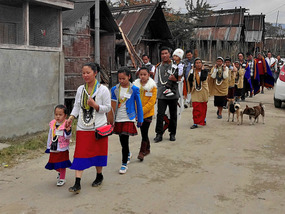
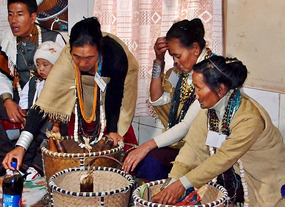
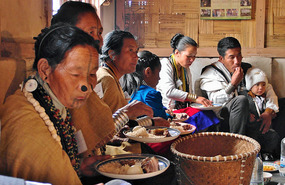
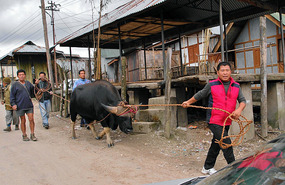

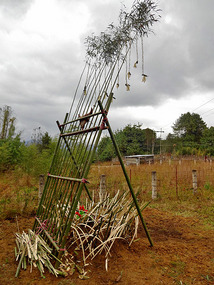

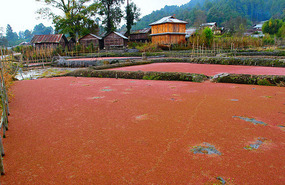
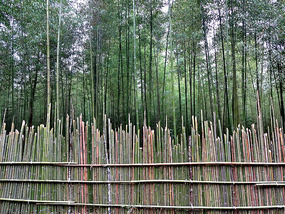
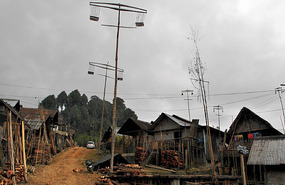
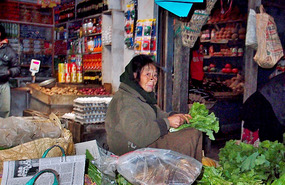
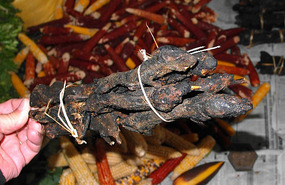

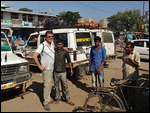
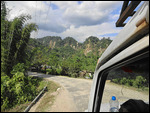

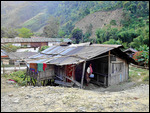
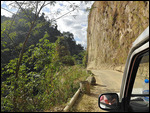
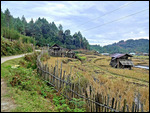
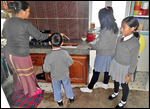

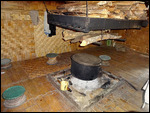

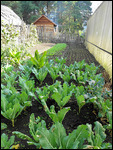
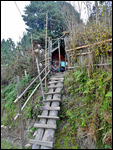


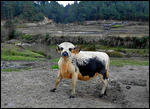
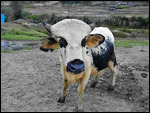

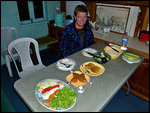

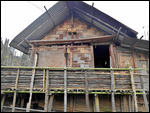
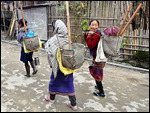

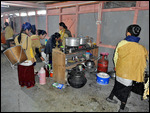
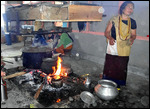

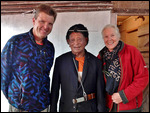
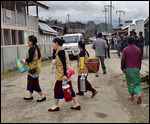
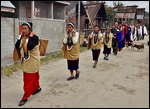
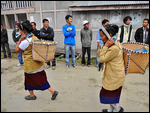



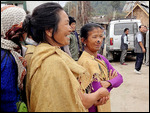
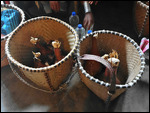

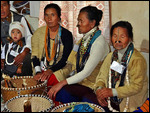





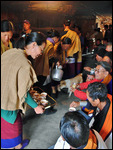
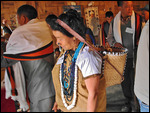

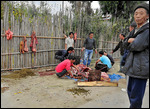
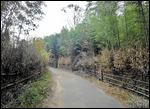
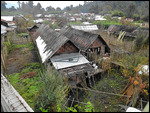
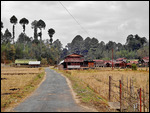

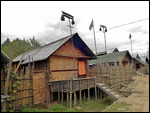
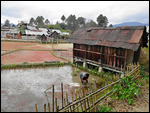
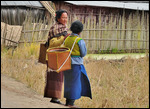
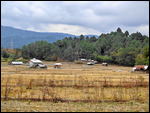


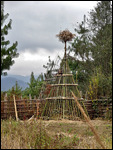

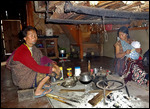

















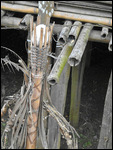
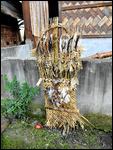



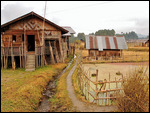


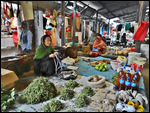




2025-05-23